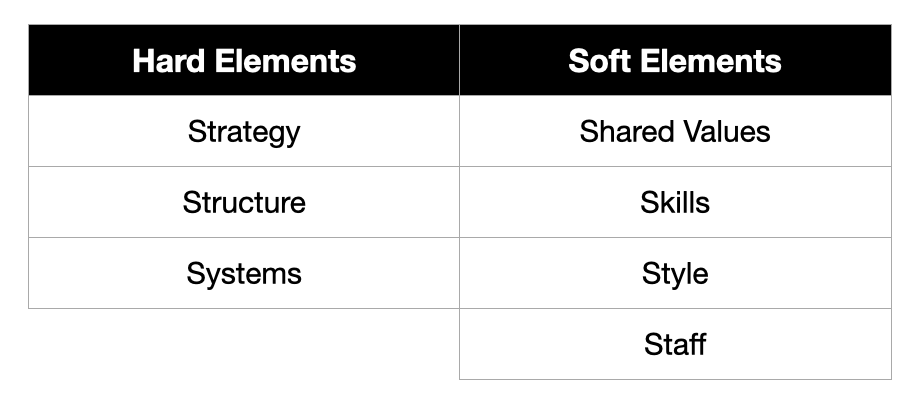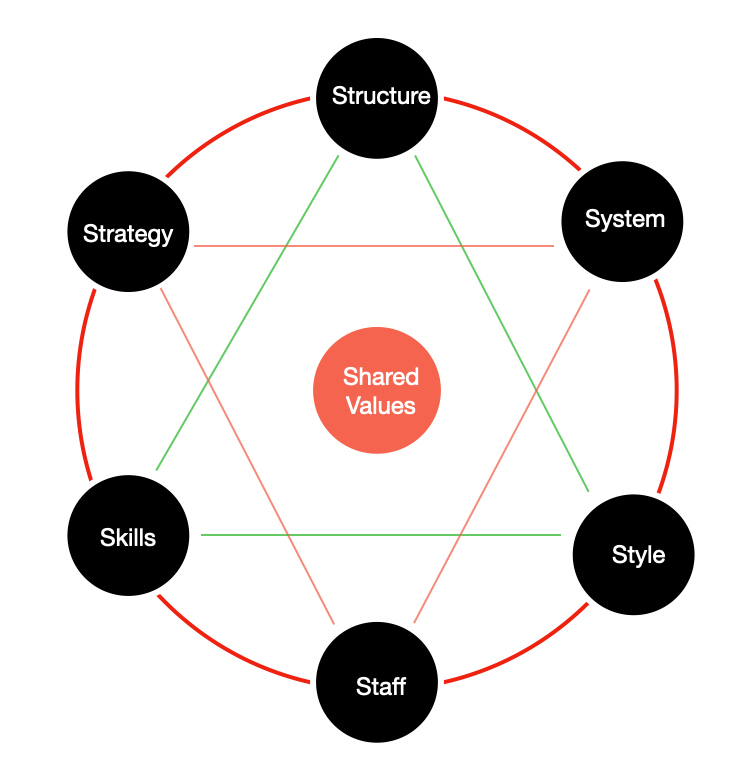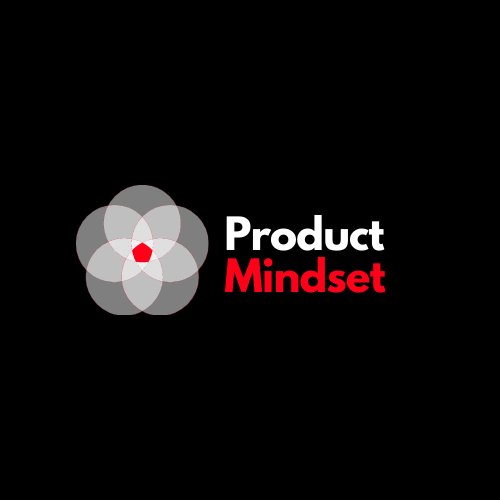Mckinsey's 7S Framework
McKinsey 7S model identifies seven elements that help organizations to achieve goals and implement change.
Hello PMs, Today’s newsletter is brought to you by our partner FotoFinish
Customers expect all your branches to be spotless. All of them, always. FotoFinish is an app that drives janitor accountability and delivers unparalleled visibility of work execution. Embed a culture of cleanliness in your company. Ask for a free trial at info@fotofinish.com
To stay on top of things, you need a plan for how to introduce change into your organization and that’s exactly where McKinsey’s 7-S Change Management Model comes into play.
What is the McKinsey 7-S Model?
McKinsey’s 7-S Change Management Model, also commonly referred to as the McKinsey 7-S Framework, is a popular change management model that was developed in the 1980s by McKinsey consultants James L. Heskett, John P. Kotter, and Leonard A. Schlesinger while working with the executives of the companies facing various difficulties from struggling sales to new product development problems.
They found that when successful companies are in trouble, they are able to quickly diagnose and tackle the root of the problem, using a common framework that involves all seven parts of an organization working together towards a common goal.
The McKinsey 7-S Model identifies seven components of an organization that must work together for effective change management: Structure, Strategy, Staff, Style, Systems, Shared Values, and Skills.
The McKinsey 7-S Model is a useful framework for people performing various roles within an organization because it acknowledges that there are aspects of organizational change that affect each component of the organization differently.
For example, if you work as a Human Resources Director, your role might involve making sure that the organizational changes do not affect staff in an adverse way and that they feel supported through the process of change.
If you work as a CEO, your focus might be on making structural changes to ensure that the organization is best positioned for growth while simultaneously trying to maintain current levels of productivity.
When to Use the McKinsey 7-S Model
The McKinsey 7-S Change Management Model is used to plan and implement organizational change.
For example, human resources departments often use this model as a way to facilitate a productive process of recruiting new staff members to the organization.
Marketing teams also use it as a way of developing effective strategies for new product development, while a banking institution might use the model to design the ways of implementing changes that will increase overall levels of customer satisfaction.
The 7-S Model is commonly used by companies that deal with operational problems, whether it’s due to a company’s current structure, or because they’ve lost sight of their organization’s vision and strategy.
The Benefits of McKinsey 7-S Model
The McKinsey 7-S Model is an effective framework for change management because:
It helps both individual employees and upper-level executives to understand various components of organizational change that affect the entire organization.
For upper-level executives, this model provides a comprehensive framework for understanding the ways that organizational change affects all areas of the organization so that it makes it possible to develop and implement a plan that will have the most effective results possible.
People who use this model typically report that it helps them motivate their staff members and that it’s an excellent way to align the entire organization around a common goal.
The model can also help to promote greater trust between different levels of management within an organization, especially if it’s used for ‘bottom-up’ change efforts focused on involving employees in the design and implementation process of organizational change.
Seven Elements of the McKinsey 7-S Framework
The model categorizes the seven elements as either "hard" or "soft":
The three "hard" elements include:
Strategy.
Structures (such as organization charts and reporting lines).
Systems (such as formal processes and IT systems.)
These elements are relatively easy to identify, and management can influence them directly.
The four "soft" elements, on the other hand, can be harder to describe, are less tangible, and are more influenced by your company culture. But they're just as important as the hard elements if the organization is going to be successful.
Let's look at each of the elements individually:
Strategy: This is your organization's plan for building and maintaining a competitive advantage over its competitors.
Structure: this is how your company is organized (how departments and teams are structured, including who reports to whom).
Systems: the daily activities and procedures that staff use to get the job done.
Shared Values: these are the core values of the organization and reflect its general work ethic. They were called "superordinate goals" when the model was first developed.
Style: the style of leadership adopted.
Staff: the employees and their general capabilities.
Skills: the actual skills and competencies of the organization's employees.
Using the McKinsey 7-S Model
You can use the model to identify which elements of the 7-S' you need to realign to improve performance or to maintain alignment and performance during other changes. These changes could include restructuring, new processes, organizational mergers, new systems, and a change of leadership.
To apply the McKinsey 7-S Model in your organization, follow these steps:
Start with your shared values: are they consistent with your structure, strategy, and systems? If not, what needs to change?
Then look at the hard elements – your strategy, structure, and systems. How well does each one support the others? Identify where changes need to be made.
Next, look at the soft elements – shared values, skills, (leadership) style, and staff. Do they support the desired hard elements? Do they support one another? If not, what needs to change?
As you adjust and align the elements, you'll need to use an iterative (and often time-consuming) process of making adjustments, and then re-analyzing how that impacts other elements and their alignment. The end result of better performance will be worth it.
Checklist Questions for the McKinsey 7-S Framework
Strategy:
What is our strategy?
How do we intend to achieve our objectives?
How do we deal with competitive pressure?
How are changes in customer demands dealt with?
How is strategy adjusted for environmental issues?
Structure:
How is the company/team divided?
What is the hierarchy?
How do the various departments coordinate activities?
How do the team members organize and align themselves?
Is decision-making centralized or decentralized? Is this as it should be, given what we're doing?
Where are the lines of communication? Explicit or implicit?
Systems:
What are the main systems that run the organization? Consider financial and HR systems, as well as communications and document storage.
Where are the controls and how are they monitored and evaluated?
What internal rules and processes does the team use to keep on track?
Shared Values:
What are your organization's core values?
What is its corporate/team culture like?
How strong are the values?
What are the fundamental values that the company/team was built on?
Style:
How participative is the management/leadership style?
How effective is that leadership?
Do employees/team members tend to be competitive or cooperative?
Are there real teams functioning within the organization or are they just nominal groups?
Staff:
What positions or specializations are represented within the team?
What positions need to be filled?
Are there gaps in required competencies?
Skills:
What are the strongest skills represented within the company/team?
Are there any skills gaps?
What is the company/team known for doing well?
Do the current employees/team members have the ability to do the job?
How are skills monitored and assessed?
Examples of McKinsey 7S Model
Let’s now take a look at McKinsey 7-S Model in action to provide you with a better understanding of how it can be used in change management.
For example, let’s say you are the CEO of Product Corp., an IT company with 500 employees.
To help grow your company, you decide to expand the business into the financial service industry. The first thing you should do is to use the McKinsey 7-S Model to assess the current state of your company.
In terms of Staff, you may find that there are certain positions within the company that need to be filled by the right people.
For example, you have a vacant position in management and there are no suitable candidates with both financial service experience and social skills that are needed to manage a team. The impact on the organization may lie behind the fact that you do not have the right people in place to make this change happen.
You should prioritize filling these positions before moving forward with your expansion plans.
Another area that needs to be assessed is Systems.
When looking at your current systems, you see that there is no standard way for employees to do their work. This means that the transition to offering financial services might be complicated.
The impact of this assessment is related to identifying a need for assessing the systems in place before making the change.
Finally, you are getting up to Strategy.
While you’re aiming to expand your business into financial services, there are other companies that have already begun offering these solutions.
The impact on the organization reflects the fact that you realize there is competition in the new industry.
The assessment leads you to prioritize research and find out how your company can differentiate itself from the competition.
By using the McKinsey 7-S model, you can better assess a situation and find the best way to move forward.
🔥 Top three quotes from our Instagram page
Help your team (and company) ship the right product for your users - Josh Elman
One can steal ideas, but no one can steal execution or passion. - Tim Ferriss
Revenue is the price your customer pays North Star metric is the value your customer gets in return for that price.







